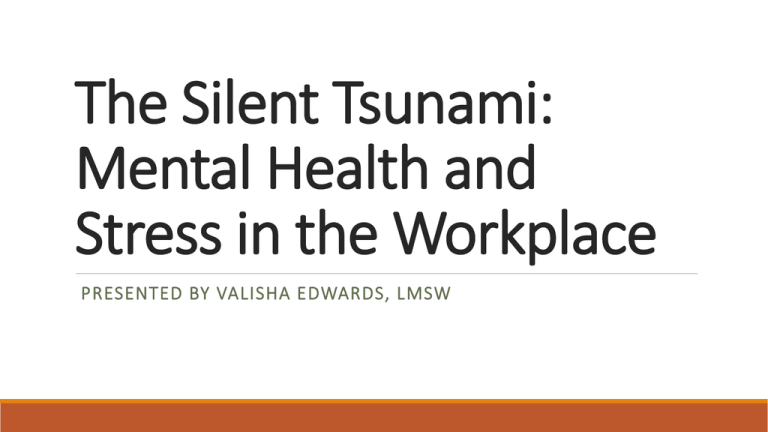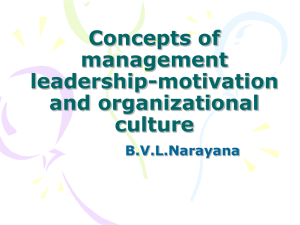The Silent Tsunami - Wales Counseling Center,PLLC
advertisement

The Silent Tsunami: Mental Health and Stress in the Workplace PRESENTED BY VALISHA EDWARDS, LMSW The Silent Tsunami: Mental Health and Stress in the Workplace Mental health issues and stress are a silent tsunami in the workplace, one that could engulf organizations in a myriad of productivity and profitability problems as well as legal liabilities unless mental health and stress are addressed as seriously as marketing, compensation and strategic plans. Persistent Mental Illness and Stress in the Workplace: Consider these names: Abraham Lincoln… Theodore Roosevelt… Winston Churchill….Alexander Hamilton. Now ask yourself these two questions. 1. What characteristic did these men have in common? 2. If offered the opportunity, would you hire them? The Silent Tsunami: Mental Health and Stress in the Workplace The answer to the second question is probably “Sure, who wouldn’t?” And the answer to the first question is a persistent mental illness. Mental illness affects millions of Americans, yet it remains among the most misunderstood of all medical maladies. The Silent Tsunami: Mental Health and Stress in the Workplace According to a US A Today report, based on research by Harvard University Medical School, untreated mental illness costs the US a minimum on $105 billion in lost productivity each year. Most organizations’ health coverage plans show that physical ailments are covered, while mental health problems lag far behind. Serious mental illnesses cost society $200 billion in lost earnings per year according to the American Journal of Psychiatry. The Silent Tsunami: Mental Health and Stress in the Workplace In this country, mental illness is the number one cause for disability for people 18-44 years of age. It costs employers an estimated $44 billion in lost productivity, but it doesn’t end there. One of five families experience mental illness. This means many of our friends and our loved ones are struggling undiagnosed, or fighting for recovery, and sadly they may be facing this alone because of our ignorance or bias. (According to Omaha.Net) The Silent Tsunami: Mental Health and Stress in the Workplace According to two studies, the United States has the dubious distinction of having the highest violent crime rate of any industrialized nation. An average of 20 workers are murdered each week in the U. S., making homicide the second highest cause of workplace deaths and the leading one for females 18, 000 non-fatal violent crimes such as sexual and other assaults occur each week while victims are working, or about a million a year. The Silent Tsunami: Mental Health and Stress in the Workplace Is this a result of mental illness in the workplace or stress? The Silent Tsunami: Mental Health and Stress in the Workplace The NIOSH Report: 40% of workers reported their job was very or extremely stressful. 25% view their jobs as the number one stressor in their lives. Three fourths of employees believe that workers have more on the job stress than a generation ago; 29% of workers felt quite a bit or extremely stressed at work; 26% of workers are “often or very often burned out or stressed by their work” Job stress is more strongly associated with health complaints than financial or family problems. The Silent Tsunami: Mental Health and Stress in the Workplace Attitudes in the American Workplace VII 80% of workers feel stress on the job; nearly half say they need help in learning how to manage stress. 42% say their co-workers need such help. 14% of respondents had felt like striking a co-worker in the past year, but didn’t. 25% have felt like screaming or shouting because of job stress, 10% are concerned about an individual at work who could become violent; 9% are aware of an assault or violent act in their workplace; and 18% had experienced some sort of threat or verbal intimidation in the past year. The Silent Tsunami: Mental Health and Stress in the Workplace Attitudes in the American Workplace VII: (continued) 65% of workers said that workplace stress has caused difficulties and more than 10% described these as having major effects. 10% said they work in an atmosphere where physical violence has occurred because of job stress and in this group, 42% report that yelling and other verbal abuse is common. 29% had yelled at co-workers; 14% said they work where machinery or equipment has been damaged because of workplace rage; and 2% admitted that they had personally struck someone. The Silent Tsunami: Mental Health and Stress in the Workplace Attitudes in the American Workplace VII: (continued) 19% (or almost one in five respondents) had quit a previous position because of job stress and nearly one in four have been driven to tears because of work place stress. 62% routinely find they end the day with work related neck pain; 44% reported stressed-out eyes; 38% complained of hurting hands; and 34% reported difficulty sleeping because they were too stressed-out; 12% had called in sick because of job stress; over half said they often spend 12 hours days on work-related duties and an equal number frequently skip lunch because of the stress of job demands. The Silent Tsunami: Mental Health and Stress in the Workplace Americans are working longer and harder! Absenteeism due to job stress has escalated! The Silent Tsunami: Mental Health and Stress in the Workplace The Silent Tsunami: Mental Health and Stress in the Workplace NASW (National Association of Social Work) report Nearly 50% of the US population, ages 15-54 report having at least one psychiatric disorder. Both severe and persistent mental disorders, including addictions can have profound consequences for individuals, their families and society affecting their ability to learn, grow into healthy adults, nurture their children, to work, to secure housing and engage in routines of daily living. The Silent Tsunami: Mental Health and Stress in the Workplace Recognizing the prevalence of mental disorders and the cost they exact from society, Social Workers make up the largest group of clinically trained mental health providers in the United States. The Silent Tsunami: Mental Health and Stress in the Workplace Why Mental Health in the Workplace Matters: Given that most people spend approximately 60% of their waking hours at work (Black 2008), understanding the financial human cost of workplace mental health can be essential to helping employees develop an action plan for improving the bottom line and employee’s well-being. Many people face mental health issues during their prime working years. Mental illness indirectly affects all Canadians at some time in their lives. (Canadian Mental Health Association, 2013). The Silent Tsunami: Mental Health and Stress in the Workplace Why Mental Health in the Workplace Matters: (continued) Mild depression, which is influenced by life stressors within and outside of the workplace, is common and is costly to employers, given its high prevalence and high productivity loss (Allen, Hyworn, Colombi, 2010). The prevalence of reported depression appears to be rising. In a 2012 workplace survey of over 6600 Canadian employees, 14% reported being currently diagnosed as clinically depressed and 8% more believe they were suffering from depression, but had not been diagnosed. A further 16% reported they have experienced depression in the past (Ipsos Reid, 2012). This survey did not ask about any other mental health issues. According to Canadians in a 2012 study, 5.2% will experience mood disorder over one year, with 4.8% of Canadians experiencing any anxiety disorder over the same time frame. Among those with a mood or anxiety disorder, 22% of those individuals will report at least two or more disorders in the same year. (Xiangefei & D’Arcy, 2012). The Silent Tsunami: Mental Health and Stress in the Workplace Early identification and treatment can be important to productivity and recovery: Mental Health Management programs in the workplace can have a positive return on investment from the employer perspective, but only when that is based on best practices (Kessler, Merikangas & Wang, 2008). 85% believe that workers with mental health conditions can be just as productive as other workers if they have access to the right supports (Ipsos Reid, 2012). The Silent Tsunami: Mental Health and Stress in the Workplace Early identification and treatment can be important to productivity and recovery: (continued) Not addressing mental health issues early can adversely affect the rate of mental health disability claims and their duration (American Psychiatric Association, 2006). Depression does not necessarily have to lead to disability in a supportive work environment. A recent review by McIntyre, Liauw and Taylor (2012) indicates that 50% or more of working individuals with depression will not seek short-term disability at any point of their work life. The Silent Tsunami: Mental Health and Stress in the Workplace Reasonable accommodations of mental health issues at work makes good business sense: The costs for providing reasonable mental-health-related accommodations are often fairly low, with most costs well under $500 per person per year (U.S. Department of Labor, Office of Disability Employment Policy, 2007). If individuals with mental illness are able to receive treatment early, disability leave, which costs companies $18,000 per episode may be avoided (Centre for Addiction and Mental Health, 2012). The Silent Tsunami: Mental Health and Stress in the Workplace Stigmas may be a barrier to productivity and/or effective treatment: Employers are perceived to be less accommodating of those experiencing mental health –related issues compared to those with physical health-related issues (Ispsos Reid, 2012). 83% of employees believe they have a responsibility to self-identify if they have a mental illness but, 31% felt their direct supervisor would not be understanding or supportive if they did so (Ispsos Reid, 2012). Stigma within the community among healthcare and vocational rehabilitation workers in the workplace, and internalized stigmas have been sited to cause 70% misdiagnosis rate (Nielson, 2010). Even though behaviors and medication side effects can be visible, mental illness is often described as an invisible disability and these traits may be assumed as personal characteristic (Brohan, Henderson Wheat et al, 2012). Experiences of discrimination and expectations for further discrimination were the most significant factor preventing workers from reporting or disclosing their mental illness to the workplace (Brohan, Henderson Wheat et al, 2012). The Silent Tsunami: Mental Health and Stress in the Workplace Management approaches can impact mental health: 4 in 5 managers/supervisors believe it is part of their job to intervene with an employee who is showing signs of depression (Ispsos Reid, 2012). Only 1 in 3 managers reported having training to intervene with employees who are showing signs of depression, but 55% of supervisors reported having intervened (Ispsos Reid, 2012). 65% of managers/supervisors say they could do their job more effectively if they found ways to more easily manage distressed employees (Ispsos Reid, 2012). 63% of managers/supervisors would like to receive training to deal with this type of situation and 43% would like to receive more support from upper management. The Silent Tsunami: Mental Health and Stress in the Workplace Advantages of promoting psychological health and safety in the workplace: Early, regular and sensitive contact with employees during sickness absences can be a key factor in enabling an early return to work (Black, 2008). Increased job stress, low job control and lower job satisfaction are associated with higher turnover. Addressing job-related stress can help retain skilled workers (Olesent, Butterworth & Rogers, 2012). The Silent Tsunami: Mental Health and Stress in the Workplace Treatment Models Used: Solution Focused Therapy NASW –The Mental Health Recovery Model Group Therapy The Silent Tsunami: Mental Health and Stress in the Workplace References NATIONAL ASSOCIATION of SOCIAL WORKERS (NASW) The American Institute of Stress CDC Center of Disease Control and Prevention Altshuler, L., J. Mintz and K. Leight. 2002. "The Life Functioning Questionnaire (LFQ): A Brief, Gender-Neutral Scale Assessing Functional Outcome." Psychiatry Research 112: 16182. American Psychiatric Association: Diagnostic and Statistical Manual of Mental Disorders, 4th edition, Text Revision. 2000. Washington, DC: American Psychiatric Press. Angst, J., M. Vollrath, K.R. Merikangas and C. Ernst. 1990. "Comorbidity of Anxiety and Depression in the Zurich Cohort Study of Young Adults." In Comorbidity of Mood and Anxiety Disorders (p. 123). Washington, DC: American Psychiatric Press. The Silent Tsunami: Mental Health and Stress in the Workplace References (continued) Arnetz, B.B. and C. Wiholm. 1997. "Psychophysiological Symptoms in Modern Offices." Journal of Psychosomatic Research 43: 35-42. Cherniss, C. 1980. Staff Burnout. Beverly Hills: Sage. Cook, R. and W. Sclenger. 2002. "Prevention of Substance Abuse in the Workplace: Review of Research on the Delivery of Services." Journal of Primary Prevention 23: 115-42. Cooper, C.L. and S. Cartwright. 1997. "An Intervention Strategy for Workplace Stress." Journal of Psychosomatic Research 43: 7-16. Dewa, C.S. and E. Lin. 2000. "Chronic Physical Illness, Psychiatric Disorder and Disability in the Workplace." Social Science and Medicine 51: 41-50. The Silent Tsunami: Mental Health and Stress in the Workplace References (continued) Dewa, C.S., P. Goering, E. Lin and M. Paterson. 2002. "Depression-related Short-Term Disability in an Employed Population." Journal of Occupation and Environmental Medicine 44: 628-33. Dewa, C.S., J.S. Hoch, E. Lin, H. Paterson and P. Goering. 2003. "Relationship Between Guideline-concordant Treatment of Depression and Employee Use of Short-term Disability Benefits." British Journal of Psychiatry 183: 91-97. Druss, B.G., R.A. Rosenheck and W.H. Sledge. 2000. "Health and Disability Costs of Depressive Illness in a Major US Corporation." American Journal of Psychiatry 157: 1274-78. Endicott, J. and J. Nee. 1997. "Endicott Work Productivity Scale (EWPS): A New Measure to Assess Treatment Effects." Psychopharmacological Bulletin 33(1): 13-16. Ewing, J.A. 1984. "Detecting Alcoholism: The CAGE Questionnaire." Journal of the American Medical Association 252: 1905-7. The Silent Tsunami: Mental Health and Stress in the Workplace References (continued) Frasure-Smith, N. and F. Lesperance. 2003. "Depression and Other Psychological Risks Following Myocardial Infarction." Archives of General Psychiatry 60: 627-36. Freudenberger, H.J. 1974. "Staff Burnout." Journal of Social Issues 30: 159-60. Frone, M.R. 2000. "Work-Family Conflict and Employee Psychiatric Disorders: The National Comorbidity Survey." Journal of Applied Psychology 85: 888-95. Gilbody, S., P. Whitty, J. Grimshaw and R. Thomas. 2003. "Educational and Organizational Interventions to Improve the Management of Depression in Primary Care: A Systematic Review." Journal of the American Medical Association 289: 3145-51 The Silent Tsunami: Mental Health and Stress in the Workplace References (continued) Goldberg, D.P. 1972. The Detection of Psychiatric Illness by Questionnaire. Oxford: Oxford University Press. Goldberg, R.J. and S. Steury. 2001. "Depression in the Workplace: Costs and Barriers to Treatment." Psychiatric Services 52: 1639-43. Greenberg, P.E., T. Sisitsky, R.C. Kessler, S.N. Finkelstein, E.R. Berndt, J.R. Davidson, J.C. Ballenger and A.J. Fyer. 1999. "The Economic Burden of Anxiety Disorders in the 1990s." American Journal of Psychiatry 60: 427-35. Greenfield, S.F., J.M. Reizes, K.M. Magruder, L.R. Muenz, B. Kopans and D.G. Jacob. 1997. "Effectiveness of Community-Based Screening for Depression." American Journal of Psychiatry 154: 1391-97. Hamilton, M. 1960. "A Rating Scale for Depression." Journal of Neurology, Neurosurgery and Psychiatry 23: 56-62.





